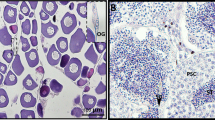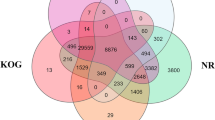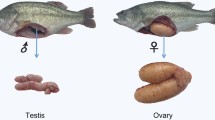Abstract
Pelophylax nigromaculatus is an important aquaculture economic animal in China, with an annual output of more than 80,000 tons in recent years. P. nigromaculatus demonstrates distinct sexual dimorphism, characterized by females being substantially larger than males. Consequently, the cultivation of female populations presents higher economic value. The RNA-Seq technology is harnessed in this study to delve into the sexual differentiation and reproductive mechanisms of these frogs. By analyzing the transcriptomes of mature testes and ovaries, 17.24 Gbp and 23.71 Gbp of clean data were obtained respectively. This analysis yielded 107,897 annotated genes, among which 8099 were differentially expressed; 4370 were upregulated and 3729 were downregulated in ovaries. GO and KEGG analyses highlighted 70 genes exhibiting sexual dimorphism. For validation, 13 differentially expressed genes were subjected to qRT-PCR, corroborating the results of transcriptome sequencing. Furthermore, the transcriptome analysis of P. nigromaculatus’ sexual glands revealed 1,062,663 SNPs, with 676,172 (63.63%) and 386,491 (36.37%) being base conversion and base transversion sites, respectively. Utilizing excel for SNP site analysis, 35,406 SNPs were identified as significantly associated with the sex of P. nigromaculatus. In pursuit of sex-related markers, 100 SNP sites, aligning perfectly with male heterozygosity and female homozygosity, were randomly selected for amplification and sequencing. Through this approach, 134 SNPs were identified, 83 (61.94%) of which matched the transcriptome data. The findings of this study provide an invaluable resource for future functional research on sex-related genes of P. nigromaculatus and offer a foundation for the development of sex-related molecular markers.






Similar content being viewed by others
Data availability
The RNA-Seq data obtained in this study are available from the NCBI (https://www.ncbi.nlm.nih.gov/), and others are presented in this study and its Supplementary Materials.
References
Abramyan J, Chun W, Peter K (2009) Cloning and expression of candidate sexual development genes in the cane toad (Bufo marinus). Dev Dyn 238:2430–2441
Behringer RR, Milton JF, Richard LC (1994) Müllerian-inhibiting substance function during mammalian sexual development. Cell 79:415–425
Brelsford A, Dufresnes C, Perrin N (2016) Trans-species variation in Dmrt1 is associated with sex determination in four European tree-frog species. Evolution 70(4):840–847
Choi JW, Bong HC, Seung HL, Seung SL, Hyeong CK, Dayeong Y, Won HC, Kyung TL, Han HC, Yong MC, Dajeong L (2015) Whole-genome resequencing analysis of Hanwoo and Yanbian cattle to identify genome-wide SNPs and signatures of selection. Mol Cells 38:466
Dilly GF, Gaitán-Espitia JD, Hofmann GE (2015) Characterization of the Antarctic sea urchin (Sterechinus neumayeri) transcriptome and mitogenome: a molecular resource for phylogenetics, ecophysiology and global change biology. Mol Ecol Resour 15:425–436
Gao J, Xiaowei W, Zhihua Z, Xiwei J, Yilei W, Ziping Z (2014) Transcriptome analysis of the differences in gene expression between testis and ovary in green mud crab (Scylla paramamosain). BMC Genomics 15:1–15
Grabherr MG, Brian JH, Moran Y, Joshua ZL, Dawn AT, Ido A, Xian A, Lin F, Raktima R, Qiandong Z (2011) Full-length transcriptome assembly from RNA-Seq data without a reference genome. Nat Biotechnol 29:644–652
He FX, Dong NJ, Yuan QH, Umar FM, Wei Y, Xue FC, Chang XT, Hua PC, Hong JS, Si PD (2019) Comparative transcriptome analysis of male and female gonads reveals sex-biased genes in spotted scat (Scatophagus argus). Fish Physiol Biochem 45:1963–1980
Heim A, Marie LN, Florian S, Thomas UM (2022) The translation regulator Zar1l controls timing of meiosis in Xenopus oocytes. Development 149:dev200900
Huang L, Zhang G, Zhang Y, Li X, Luo Z, Liu W, Luo F, Liu H, Yin S, Jiang J (2023) Profiling genetic breeding progress in bagrid catfishes. Fishes 8(8):426
Huntriss J, Gosden R, Hinkins M, Oliver B, Miller D, Rutherford AJ, Picton HM (2002) Isolation, characterization and expression of the human Factor In the Germline alpha (Figla) gene in ovarian follicles and oocytes. Mol Hum Reprod 8:1087–1095
Lei L, Zhu J, Chen C, Wang Y, Liu X, Hong X, Yu L, Wei C, Li W, Zhu X (2023) Analysis of SSR and SNP characteristics and screening of sex-linked markers in Chinese soft-shelled turtle based on transcriptome sequencing. J Guangdong Ocean Univ 43(1):25–32
Li X, Zhao W, Guo Y, Xue J (2001) Development of sexual gland and influence of temperature on sexual differentiation in Rana chensinensis. Zool Res 22(5):351–356
Li M, Huihui Y, Jiue Z, Lingling F, Hongjuan S, Mengru L, Yunlv S, Xianbo Z, Dongneng J, Linyan Z (2014) Efficient and heritable gene targeting in tilapia by CRISPR/Cas9. Genetics 197:591–599
Li XY, Lei L, Zhang Y (2019) Identification and expression of Dmrt1 and Sox9 during the gonadal differentiation of Rana chensinensis. Turkish J Zool 43(4):319–330
Li P, Wei L, Wanqiao L, Jilong W (2022) Biochemical indices, gene expression, and SNPs associated with salinity adaptation in juvenile chum salmon (Oncorhynchus keta) as determined by comparative transcriptome analysis. PeerJ 10:e13585
Li X, Jie M, Chu T, Xiao L, Jian F (2022) Sex determination mechanisms and sex control approaches in aquaculture animals. Sci Chin Life Sci 65:1091–1122
Liu L, Tian L, Shaoxuan W, Yajuan L, Huilan W, Lijing Z, Ya S, Yaxin Y, Qiang X, Shi W (2022) Discovery of Nanos1 and Nanos2/3 as germ cell markers during scallop gonadal development. Mar Biotechnol 24:408–416
Liu F, Zhang X, Wei X, Li Y, Liu W, Gan G, Xiao L, Wang X, Luo H (2023) Gonadal transcriptome analysis of paradise fish Macropodus opercularis to reveal sex-related genes. Comp Biochem Physiol D: Genomics Proteomics 48:101125
Liu H, Xia W, Li B (2023) Sex-specific markers developed by 2b-RAD and genome sequencing reveal an XX/XY sex-determination system in mud carp (Cirrhinus molitorella). Aquaculture 565:739131
Mallory D, Johnson MJ, Stuckert AMM, Summers K (2023) A histological analysis of coloration in the Peruvian mimic poison frog (Ranitomeya imitator). PeerJ 11:e15533
Mayer LP, Stefanie LO, Chery AD, Catherine RP (2002) Sexually dimorphic expression of steroidogenic factor 1 (Sf1) in developing gonads of the American bullfrog, Rana catesbeiana. Gen Comp Endocrinol 127:40–47
Ming Z, Brittany V, Stefan BF, Vincent H (2022) Sox9 in organogenesis: shared and unique transcriptional functions. Cell Mol Life Sci 79:522
Oshima Y, Kiyoshi N, Yoriko N, Masahisa N (2009) Sox3: a transcription factor for Cyp19 expression in the frog Rana rugosa. Gene 445:38–48
Pan ZJ, Zhu CK, Chang GL (2021) Differential expression analysis and identification of sex-related genes by gonad transcriptome sequencing in estradiol-treated and non-treated Ussuri catfish Pseudobagrus ussuriensis. Fish Physiol Biochem 47:565–581
Park JK, Chung KW, Kim JY (2022) Population structure and morphological pattern of the black-spotted pond frog (Pelophylax nigromaculatus) inhabiting watershed areas of the Geum River in South Korea. Sustainability 14(24):16530
Pightling AW, Nicholas P, Franco P (2015) Choice of reference-guided sequence assembler and SNP caller for analysis of Listeria monocytogenes short-read sequence data greatly influences rates of error. BMC Res Notes 8:1–9
Piprek RP, Anna P, Katarzyna LK, Jacek ZK, Jacek MS (2014) Sexual dimorphism of Amh, Dmrt1 and Rspo1 localization in the developing gonads of six anuran species. Int J Dev Biol 57:891–895
Prihatini R, Dinarti D, Sutanto A (2023) Sex-linked single nucleotide polymorphism (SNP) identification and molecular marker development of salacca (Salacca zalacca (Gaertn.) Voss). Biodiversitas J Biol Divers 24(2):704–712
Raymond CS, Caroline ES, Michael MS, Kelly JS, Betsy H, Jonathan H, David Z (1998) Evidence for evolutionary conservation of sex-determining genes. Nature 391:691–695
Shurui L, Wang X, Lu Y, Wang J, Yu D, Zhou Z, Wei J, Liu L, Liu J, Liu F, Su Y, Xu H (2023) Co-infections of Klebsiella pneumoniae and Elizabethkingia miricola in black-spotted frogs (Pelophylax nigromaculatus). Microb Pathog 180:106150
Sigang F, Guo Y, Xu Y (2021) Comparative transcriptome analysis of the ovary and testis in noble scallop (Chlamys nobilis). Pak J Zool 53:251
Smith CA, Kelly NR, Thomas O, David MC, Peter GF, Timothy JD, Andrew HS (2009) The avian Z-linked gene Dmrt1 is required for male sex determination in the chicken. Nature 461:267–271
Suda M, Maho K, Yuki O, Kazutoshi Y, Yoriko N, Shigeyasu T, Sakae K, Masahisa N (2011) Up-regulation of Fshr expression during gonadal sex determination in the frog Rana rugosa. Gen Comp Endocrinol 172:475–486
Takase M, Satoru N, Masahisa N (2000) Two Sox9 messenger RNA isoforms: isolation of cDNAs and their expression during gonadal development in the frog Rana rugosa. FEBS Lett 466:249–254
Tang Y, Chen JY, Ding GH, Lin ZH (2021) Analyzing the gonadal transcriptome of the frog Hoplobatrachus rugulosus to identify genes involved in sex development. BMC Genomics 22:1–13
Tompsett RA, Steve W, Eric H, John PG, Markus H (2013) Effects of exposure to 17 alpha -ethynylestradiol during larval development on growth, sexual differentiation, and abundances of transcripts in the liver of the wood frog (Lithobates sylvaticus). Aquat Toxicol 126:42–51
Tsakogiannis A, Manousaki T, Lagnel J, Sterioti A, Pavlidis M, Papandroulakis N, Mylonas CC, Tsigenopoulos CS (2018) The transcriptomic signature of different sexes in two protogynous hermaphrodites: insights into the molecular network underlying sex phenotype in fish. Scientific Reports 8:3564
Wu YK, Heng YF (2022) Revisiting Zar proteins: the understudied regulator of female fertility and beyond. Cell Mol Life Sci 79:92
Xiao L, Yin G, Dengdong W, Mi Z, Xin H, Shuisheng L, Haoran L, Yong Z (2020) Beta-hydroxysteroid dehydrogenase genes in orange-spotted grouper (Epinephelus coioides): genome-wide identification and expression analysis during sex reversal. Front Genet 11:161
Yan H, Xin C, Xufang S, Lianshun W, Linan J, Haiying L, Ying L, Qi L, Chen J (2018) De novo transcriptome analysis and differentially expressed genes in the ovary and testis of the Japanese mantis shrimp Oratosquilla oratoria by RNA-Seq. Comp Biochem Physiol D: Genomics Proteomics 26:69–78
Yao Z, Frank MY, Amidou ND, Ron EK, Curt MC, Colin WH, Curtis P, Wayne X (2020) Evaluation of variant calling tools for large plant genome re-sequencing. BMC Bioinformatics 21:1–16
Yao H, Lin Z, Dong Y, Kong X, He L, Xue L (2021) Gonad transcriptome analysis of the razor clam (Sinonovacula constricta) revealed potential sex-related genes. Front Mar Sci 8:725430
Yoshimoto S, Ema O, Hirohito U, Kei T, Yoshinobu U, Chizuko NU, Yoichi M, Nobuhiko T, Tadayoshi S, Michihiko I (2008) A W-linked DM-domain gene, Dm-w, participates in primary ovary development in Xenopus laevis. Proc Natl Acad Sci 105:2469–2474
Zhang X, Mengru L, He M, Xingyong L, Hongjuan S, Minghui L, Deshou W (2017) Mutation of foxl2 or cyp19a1a results in female to male sex reversal in XX Nile tilapia. Endocrinology 158:2634–2647
Funding
This work was supported by the Natural Science Foundation of Hunan Province (Grant No. 2022JJ40167) and by the Industry-University-Research Cooperation Program of the College of Fisheries of Hunan Agricultural University (Grant No. xczx-2024006).
Author information
Authors and Affiliations
Contributions
XYZ, GW, and YZH designed the study. XYZ, GW, and ZWL performed the experiments. LLY, XYZ, and GW performed data analysis and interpretation. QFW and GW prepared the figures. XYZ wrote the manuscript. XQW, STX, and YZH revised the manuscript. All authors read, commented, and approved the manuscript. All authors have read and agreed to the published version of the manuscript.
Corresponding authors
Ethics declarations
Ethics approval and consent to participate
Animal experiments complied with the regulations of the Animal Care and Use Committee of the College of Fisheries, Hunan Agricultural University (Changsha, China; Approval Number: 202305012; Approval Date: May 12, 2023).
Conflict of interest
The authors declare no competing interests.
Additional information
Handling Editor: Pierre Boudry
Publisher's Note
Springer Nature remains neutral with regard to jurisdictional claims in published maps and institutional affiliations.
Rights and permissions
Springer Nature or its licensor (e.g. a society or other partner) holds exclusive rights to this article under a publishing agreement with the author(s) or other rightsholder(s); author self-archiving of the accepted manuscript version of this article is solely governed by the terms of such publishing agreement and applicable law.
About this article
Cite this article
Zhang, X., Wan, G., Li, Z. et al. Integrated transcriptome and SNP analysis reveals sex-related genetic insights in the black-spotted frog (Pelophylax nigromaculatus). Aquacult Int (2024). https://doi.org/10.1007/s10499-024-01463-x
Received:
Accepted:
Published:
DOI: https://doi.org/10.1007/s10499-024-01463-x




